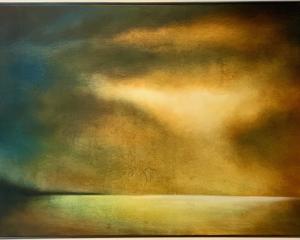
''For Whom the Wind Blows'', Barry Cleavin (Brett McDowell Gallery)
Barry Cleavin can always be relied on for a fine exhibition laced with humour.
His current display at the Brett McDowell Gallery is no exception, though the humour has been muted as the artist presents a transition between his Christchurch work and that of his new Otago Peninsula home.
Otago was the lucky recipient of Cleavin after his exodus following Christchurch's earthquake disaster, and the aftermath of that event still casts a certain pall over his art.
The Christchurch works are busy and nervy, and the fractured images of Coleridge Power Station make direct reference to living on a fault line.
By comparison, Cleavin's peninsula works are calm, stylish images which combine drawing, printmaking and photography.
These works depict the land with more than a hint of Japanese sumi-e style.
A further series of works imply wind through the shadows of clothes moving round a rotary clothesline.
These bring out the inventive and whimsical in the artist; the works are presented on a clothes airer and pegged to a clothesline running the length of one wall of the gallery.
The exhibition accompanies the recent publication of a book of Cleavin's work, Lateral Inversions, and to commemorate this fact, a further clothesline filled with older Cleavin works acts as a miniature retrospective.

''Stretching Time'', Steve Carr (Dunedin Public Art Gallery)
Steve Carr's exhibition at the Dunedin Public Art Gallery does its best to live up to its ambitious title, and, for the patient viewer, succeeds.
The display consists of three works, two small pieces bookending an immersive looped video.
The introductory Range gives some idea of the thinking behind the exhibition.
An array of sliced hemispheres of golf ball is displayed, their disparate interiors forming a grid which references scientific studies.
We are presented with quanta of golf ball, parcels of colour which reflect the theories that time and energy may be expressed in a similar way.
Beyond this display, time slows down.
We enter a room where massive carnations which have been immersed in coloured liquid change form and colour with glacial slowness.
The massive wall-sized video is both hypnotic and beautiful, and imbues the viewer with a Zen-like peace.
This time-dilated nature is counterbalanced by the third work, a video showing an entirely artificial scene imitating nature - a model bird, placed against a fake background under lights which pass through dawn, day, and dusk in 15 minutes.
The staged nature of this scene is never less than evident, and the somewhat creepy artificiality is reminiscent of precise and sinister undercurrents in the work of artists and cinematographers ranging from David Lynch to Cindy Sherman.

''Bloom'', Jon Thom (The Artist's Room)
Slowly changing flowers are also an aspect of Jon Thom's exhibition.
Thom, best known for his excellent monochrome portraits, has here revealed another string to his bow.
Thom's exhibition juxtaposes a series of beautiful muted photographic images of slowly decaying flowers with his better known portraits of attractive young women, and motifs from the flowers have been overlaid on the portraits in bold blue or red.
Though not stated directly, the message is clear - these are vanitas works, and the fresh blush of youthful human form is no less fleeting than the gently decaying petals.
As always, Thom's portraits are beautiful, and the emphasis has been placed primarily on strong expression, both in terms of the artist's style and the looks on his subjects' faces.
The subjects, largely taken from anonymous photographs sourced online, have been effectively portrayed with well-drawn emotions which speak clearly to the viewer.
There has been a distinct progression from the artist's previous work, through an expansion in the media used and a loosening up of style.
Wax crayon, conte, pastel, and charcoal have been intermixed, producing works with a textural depth which makes them more vivid and lively, making the implication of the fading beauty that much more poignant.
As the poet Herrick so aptly said, ''this same flower that smiles today, tomorrow will be dying''.












